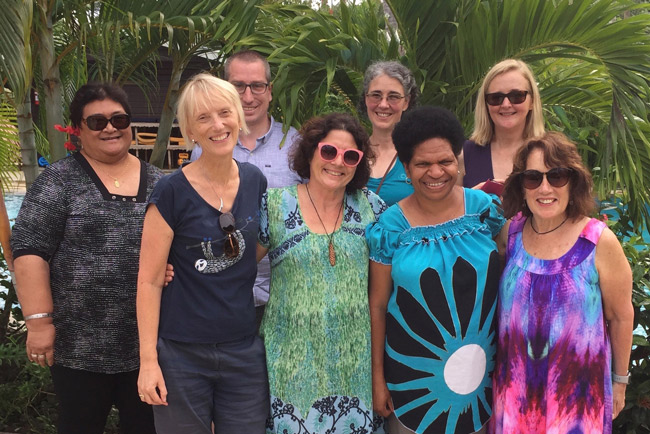
Members of the “CC-triple-P” (Cervical Cancer Prevention Programme in the Pacific) in Apia last week (from left) Dr Maria Kerslake, Associate Professor Merilyn Hibma, Dr David Hawkes, Professor Bev Lawton, Dr Jo-Ann Stanton, Ms Paula Puawe, Associate Professor Marion Saville and Professor Stacie Geller.
University of Otago researchers and clinicians are helping lead development of a cervical cancer prevention programme in the Pacific, aimed at saving lives.
Associate Professor Merilyn Hibma from the Department of Pathology says cervical cancer is the fourth most common cancer among women globally and in Western Samoa alone, the World Health Organisation estimates about 20 women out of about 100,000 are dying of cervical cancer annually.
New technologies have enabled accessible screening of women for the causal virus, human papillomavirus (HPV). Self-testing and point-of-care testing are now both options that may be of benefit to women's health, by reducing the costs of delivering the service and reducing the burden of the disease, Associate Professor Hibma explains.
The initial opportunity to be addressed is the development of an innovative package of community-based HPV testing and treatment for the prevention of cervical cancer, designed to meet the needs of Pacific nations with limited resources.
"From what we can tell, women in the Pacific are ready for this technology."
Associate Professor Hibma is principal investigator in the “CC-triple-P” collaboration, funded through the New Zealand Ministry of Business, Innovation and Employment, aimed at improving screening, prevention and treatment for cervical cancer in the Pacific.
The group organised a stakeholder workshop in Apia last week to inform participants and to facilitate engagement and a pathway forward. This was followed by a research planning workshop the following day.
The first workshop helped identify the need and desire for HPV testing and treatment in Pacific nations as well as any gaps in knowledge of the sociocultural, technological and clinical applications of the approach that require a better understanding to enable successful implementation in the Pacific context.
The second workshop was focused on planning for research that will help enable the pathway to implementation and included discussion on funding opportunities, resources, protocols, communication frameworks and project governance.
As a result of the workshops, the Samoan Minister of Health has asked the collaborative research team to prepare a proposal based on use of the new technologies for perusal by Cabinet.
“From what we can tell, women in the Pacific are ready for this technology,” Associate Professor Hibma says. “However, we need to ensure that there will be appropriate treatment and follow-up for these women once they have done the testing.”
Other University of Otago researchers and clinicians involved in the collaboration are Dr Jo-Ann Stanton, a Senior Research Fellow from the Department of Anatomy; Associate Professor Peter Sykes, Gynaecological Oncologist, from the University of Otago, Christchurch and Professor Alec Ekeroma who will be joining the Obstetrics and Gynaecology Department at the University of Otago, Wellington, in August.
